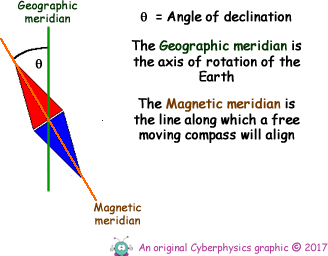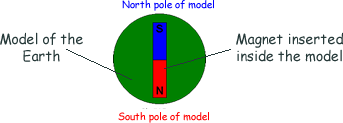    |
||||

|
||||
The Earth's magnetic north is not at the 'true' north. The Earth rotates around an imaginary line that joins the 'true north' and 'true south' poles that we call the Earth's Axis or the 'Geographical Meridian'.
Magnetic DeclinationThe line joining the magnetic north and magnetic south is inclined at an angle to the true axis line.
The angle between them is called the magnetic declination. Magnetic declination varies both from place to place and with the passage of time. As a traveller cruises the east coast of the United States, for example, the declination varies from 16o west in Maine, to 6o in Florida, to 0o in Louisiana, to 4o east (in Texas). The declination at London, UK is 1o 7' west (2014), and as the country is quite small that figure is fairly good for the whole of the country. Magnetic declination is reducing, and it is predicted that in about 2050 it will be zero. What causes the Earth's magnetic field?The Earth has a substantial magnetic field that is thought to be due to the movement of the charged particles in the liquid core. Moving charges produce magnetic fields and also electric currents. The origin of the Earth's magnetic field is not completely understood by scientists, but is thought to be associated with electrical currents produced by the spinning of the liquid metallic outer core (made of iron and nickel) creating convection currents within this layer. This mechanism is called the dynamo effect The magnetic field of the Earth is not fixed. Rocks formed from the molten state contain indicators of the magnetic field at the time of their solidification. The study of such "magnetic fossils" indicates that the Earth's magnetic field reverses itself every million years or so (the north and south magnetic poles switch). Why this should happen is a source of debate for scientists. If a piece of magnetised iron is suspended freely (hung from a fine thread or 'floated' on a pivot) it aligns itself with the field lines from the Earth's core. This played an important role in the development of mankind's navigation skills. The stars could be used to navigate by at night providing they were not hidden by clouds. Magnetic compasses 'worked' regardless of the weather and therefore played an important part in our exploration of planet. The 'north' poles on these little compasses sought out the magnetic north whether or not there was cloud cover. They were called 'north poles'.
The magnetic field protects the EarthMagnetic fields exert forces on moving electrical charges. So, the Earth's magnetic field can trap charged particles moving in the atmosphere, making them spiral back and forth along the field lines. The solar wind is a stream charged particles that are emitted from our Sun. The Earth's magnetic field shields us from much of the solar wind as it deflects many of the particles out into space and traps some of them in the upper atmosphere. It was discovered in the late 1950s that the Earth is surrounded by two regions of particularly high concentration of charged particles called the Van Allen radiation belts. It is believed that most of these particles come from our Sun. These charged particles trapped in the Earth's magnetic field are responsible for the aurora (Northern and Southern Lights) seen in the sky around the poles.
LOJ (August 2001 - updated 2017) |
||||
 |
||||

 The
Earth's Magnetic Field
The
Earth's Magnetic Field 

 This makes precise navigation
by the magnetic compass a complicated matter. The axis line for the
geographical true north/south is called the geographical meridian
and the axis line joining the magnetic north/south is called the magnetic
meridian.
This makes precise navigation
by the magnetic compass a complicated matter. The axis line for the
geographical true north/south is called the geographical meridian
and the axis line joining the magnetic north/south is called the magnetic
meridian. 


